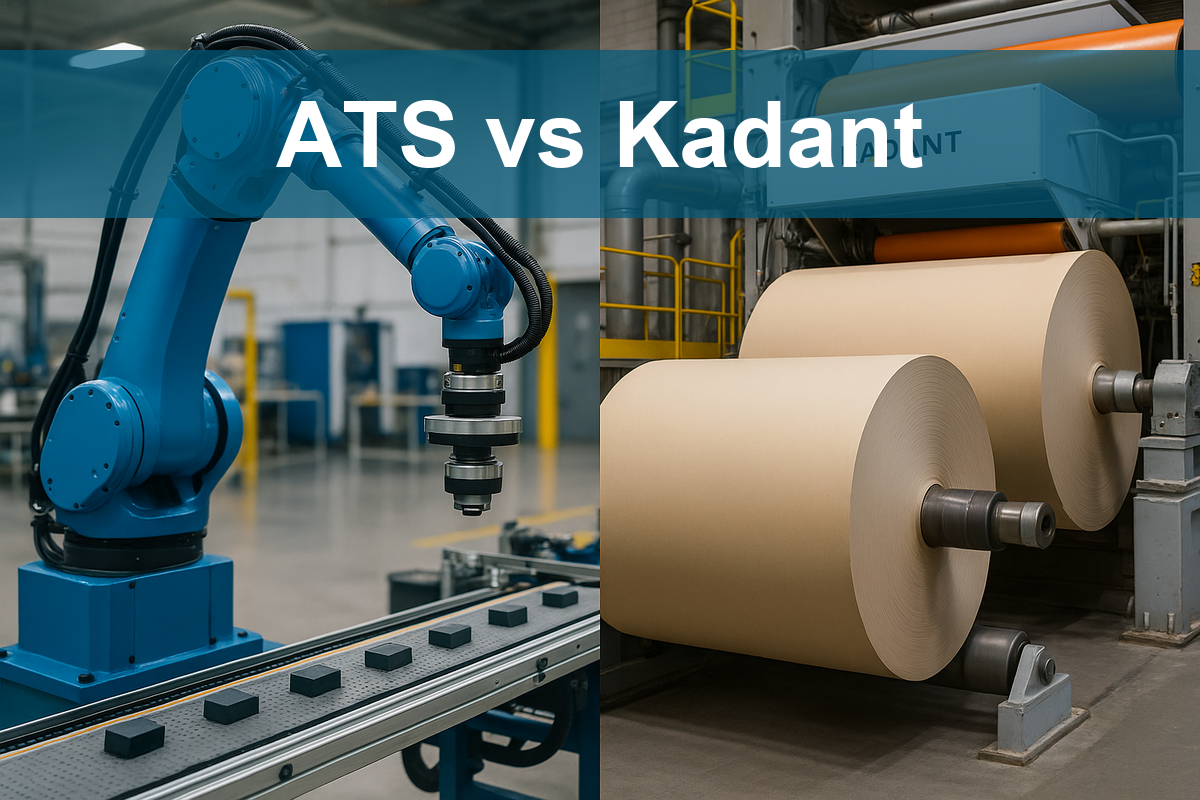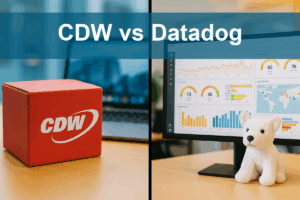In today’s competitive marketplace, selecting the right investments requires a careful analysis of companies within the same industry. This article compares ATS Corporation and Kadant Inc., both key players in the Industrial – Machinery sector, known for their innovative automation solutions. With overlapping market interests and distinct approaches to technology and services, understanding their strengths can illuminate the best investment opportunity. Join me as we explore which company stands out as the more compelling choice for investors.

Table of contents
Company Overview
ATS Corporation Overview
ATS Corporation is a prominent player in the automation solutions sector, providing a comprehensive suite of services designed to enhance manufacturing and assembly systems across various industries. Founded in 1978 and headquartered in Cambridge, Canada, ATS operates with a workforce of approximately 7,500 employees. The company’s mission is to drive operational efficiency and sustainability through innovative automation technologies, including software solutions for real-time machine performance analysis. With a market capitalization of about 2.50B, ATS serves diverse sectors such as life sciences, transportation, and energy. As a key player on the New York Stock Exchange, ATS is committed to delivering value-added engineering and manufacturing capabilities to its clients.
Kadant Inc. Overview
Kadant Inc. specializes in engineered systems and technologies tailored for industrial applications, boasting a strong international presence. Incorporated in 1991 and based in Westford, Massachusetts, Kadant operates with around 3,500 employees. The company focuses on providing fluid-handling systems, material handling equipment, and industrial processing solutions, primarily for the packaging and wood products industries. With a market capitalization of approximately 3.28B, Kadant is recognized for its commitment to innovation and efficiency. The company trades on the New York Stock Exchange and emphasizes sustainable practices throughout its product offerings.
Key similarities and differences
Both ATS Corporation and Kadant Inc. operate in the industrial machinery sector and focus on enhancing operational efficiency through innovative solutions. However, their business models differ significantly; ATS emphasizes automation solutions and integrated systems across various industries, while Kadant concentrates on fluid-handling technologies and engineered systems primarily for specific sectors like packaging and wood products.
Income Statement Comparison
In this section, I present a comparative income statement for ATS Corporation and Kadant Inc. to evaluate their financial performance in the most recent fiscal year.
| Metric | ATS Corporation | Kadant Inc. |
|---|---|---|
| Market Cap | 2.50B | 3.28B |
| Revenue | 2.53B | 1.05B |
| EBITDA | 168M | 223M |
| EBIT | 15M | 173M |
| Net Income | -28M | 112M |
| EPS | -0.29 | 9.51 |
| Fiscal Year | 2025 | 2024 |
Interpretation of Income Statement
The analysis reveals contrasting trends between ATS Corporation and Kadant Inc. ATS experienced a decline in revenue from the previous year, resulting in a negative net income, indicating operational challenges. In contrast, Kadant demonstrated robust performance with significant revenue growth and a solid net income, reflecting improved operational efficiency. Kadant’s margins have remained stable, showcasing resilience in its business model, while ATS’s margins have contracted, highlighting a need for strategic adjustments moving forward.
Financial Ratios Comparison
The table below presents a comparison of the most recent financial ratios for ATS Corporation (ATS) and Kadant Inc. (KAI).
| Metric | ATS | KAI |
|---|---|---|
| ROE | -1.64% | 13.17% |
| ROIC | 0.09% | 10.08% |
| P/E | -125.28 | 36.90 |
| P/B | 2.06 | 4.86 |
| Current Ratio | 1.69 | 2.31 |
| Quick Ratio | 1.41 | 1.55 |
| D/E | 0.99 | 0.38 |
| Debt-to-Assets | 36.79% | 11.54% |
| Interest Coverage | 0.09 | 8.55 |
| Asset Turnover | 0.55 | 0.74 |
| Fixed Asset Turnover | 5.66 | 6.18 |
| Payout Ratio | 0% | 13.15% |
| Dividend Yield | 0% | 0.36% |
Interpretation of Financial Ratios
The financial ratios indicate a stark contrast between ATS and KAI. ATS shows negative ROE and P/E ratios, reflecting potential challenges in profitability and valuation, while KAI demonstrates strong performance with positive ratios across the board, including a solid ROE of 13.17%. ATS’s high debt levels (D/E of 0.99) raise concerns about financial stability compared to KAI’s lower leverage (D/E of 0.38). These factors suggest that KAI may be a more stable investment choice, while ATS presents higher risks.
Dividend and Shareholder Returns
ATS Corporation does not pay dividends, reflecting a focus on reinvestment to address its negative net income and a high-growth strategy. This approach might prioritize long-term shareholder value, although it poses risks if not managed properly. The company engages in share buybacks, which can enhance shareholder returns when executed wisely.
In contrast, Kadant Inc. distributes a modest dividend of $1.25 per share, with a payout ratio of 13%. This indicates a balanced approach to returning value while maintaining capital for growth. Its consistent cash flow supports sustainable dividend payments, suggesting a solid strategy for long-term shareholder value creation.
Strategic Positioning
ATS Corporation and Kadant Inc. both operate in the Industrial Machinery sector, facing competitive pressures from each other and other players. ATS holds a market cap of approximately 2.5B, while Kadant’s market cap is around 3.3B. Kadant’s diverse product lines in flow control and material handling give it a competitive edge, particularly in the fluid-handling market, where it commands a significant share. Both companies must navigate technological disruptions and shifting market demands to maintain their positions.
Stock Comparison
In examining the weekly stock price movements of ATS Corporation (ATS) and Kadant Inc. (KAI) over the past year, we observe significant fluctuations influencing trading dynamics, which warrant careful analysis for potential investors.

Trend Analysis
ATS Corporation (ATS) has experienced a substantial decline of -37.73% over the past year. This bearish trend indicates a consistent downward trajectory, compounded by a recent price change of -6.39%. The overall trend shows signs of deceleration with a standard deviation of 4.45, reflecting heightened volatility. The stock reached a high of 43.82 and a low of 23.5, suggesting a challenging period for investors.
Conversely, Kadant Inc. (KAI) has enjoyed a positive shift with a 7.49% increase in stock price over the past year, indicating a bullish trend, despite a recent downturn of -11.29%. This recent decline may suggest a temporary setback, as the overall acceleration status is also marked as deceleration, with a standard deviation of 35.59. The stock has fluctuated between a high of 419.01 and a low of 254.91 during this period.
In summary, ATS exhibits a bearish trend with significant volatility, whereas KAI, although currently facing a short-term decline, displays a long-term bullish outlook. Careful consideration of these trends is essential for informed investment decisions.
Analyst Opinions
Recent analyst recommendations for ATS Corporation (ATS) indicate a cautious stance, with a rating of C. Analysts cite concerns over low scores in return on equity and debt-to-equity ratios as primary factors for their hold position. In contrast, Kadant Inc. (KAI) has received a more favorable rating of B+, with analysts highlighting strong performance in return on assets and discounted cash flow as reasons to recommend a buy. For 2025, the consensus leans towards a buy for KAI, while ATS remains a hold.
Stock Grades
In this section, I’ll present the latest stock grades for ATS Corporation and Kadant Inc., highlighting the insights from reputable grading companies.
ATS Corporation Grades
| Grading Company | Action | New Grade | Date |
|---|---|---|---|
| JP Morgan | maintain | Neutral | 2024-08-13 |
| Goldman Sachs | maintain | Sell | 2024-08-13 |
| JP Morgan | maintain | Neutral | 2024-05-24 |
Kadant Inc. Grades
| Grading Company | Action | New Grade | Date |
|---|---|---|---|
| Barrington Research | maintain | Outperform | 2025-10-30 |
| Barrington Research | maintain | Outperform | 2025-10-29 |
| Barrington Research | maintain | Outperform | 2025-10-27 |
| Barrington Research | maintain | Outperform | 2025-10-10 |
| Barrington Research | maintain | Outperform | 2025-09-23 |
| DA Davidson | maintain | Neutral | 2025-08-04 |
| Barrington Research | maintain | Outperform | 2025-07-30 |
| Barrington Research | maintain | Outperform | 2025-07-29 |
| DA Davidson | maintain | Neutral | 2025-05-01 |
| Barrington Research | maintain | Outperform | 2025-05-01 |
The overall trend in grades indicates that ATS Corporation is receiving cautious recommendations with a mix of Neutral and Sell ratings, suggesting potential challenges ahead. In contrast, Kadant Inc. shows a consistent positive sentiment from Barrington Research, maintaining an Outperform rating, which reflects strong confidence in its future performance.
Target Prices
The consensus target prices from analysts for ATS Corporation and Kadant Inc. are as follows:
| Company | Target High | Target Low | Consensus |
|---|---|---|---|
| ATS Corporation | 34 | 34 | 34 |
| Kadant Inc. | 410 | 275 | 342.5 |
For ATS Corporation, the target consensus aligns perfectly with the current stock price of $25.51, suggesting a significant upside potential. In contrast, Kadant Inc. has a consensus target of $342.5, compared to its current price of $278.12, indicating a favorable outlook from analysts.
Strengths and Weaknesses
The following table summarizes the strengths and weaknesses of ATS Corporation and Kadant Inc., based on their most recent performance metrics.
| Criterion | ATS Corporation | Kadant Inc. |
|---|---|---|
| Diversification | Moderate | High |
| Profitability | Low | High |
| Innovation | Moderate | High |
| Global presence | Moderate | Strong |
| Market Share | Low | High |
| Debt level | Moderate | Low |
In summary, while Kadant Inc. shows stronger profitability, innovation, and market presence, ATS Corporation faces challenges in profitability and market share. Investors should weigh these factors carefully when considering their investment options.
Risk Analysis
The table below summarizes key risks that ATS Corporation and Kadant Inc. face in their operations.
| Metric | ATS Corporation | Kadant Inc. |
|---|---|---|
| Market Risk | High | Moderate |
| Regulatory Risk | Moderate | Low |
| Operational Risk | High | Moderate |
| Environmental Risk | Moderate | Low |
| Geopolitical Risk | Moderate | Low |
Both companies face significant market risk due to their exposure to global economic fluctuations. ATS Corporation’s operational challenges and high volatility make it more susceptible to adverse market conditions compared to Kadant Inc., which enjoys a more stable operational framework.
Which one to choose?
When comparing ATS Corporation (ATS) and Kadant Inc. (KAI), the latter appears to be the more favorable choice for investors. KAI has a higher gross profit margin of 44% compared to ATS’s 26%, indicating a stronger ability to manage costs. Additionally, KAI’s return on equity (ROE) is significantly better at 13% versus ATS’s negative ROE. Analyst ratings further reflect this, with KAI rated B+ compared to ATS’s C.
For growth-focused investors, KAI’s recent stock performance is bullish, with a price increase of 7.49%, whereas ATS’s trend is bearish, down 37.73%. However, investors should consider the risks, including market competition and valuation uncertainties in both industries.
Recommendation: Growth-focused investors may prefer KAI, while those seeking stability could consider ATS, albeit with caution.
Disclaimer: This article is not financial advice. Each investor is responsible for their own investment decisions.
Go further
I encourage you to read the complete analyses of ATS Corporation and Kadant Inc. to enhance your investment decisions:



